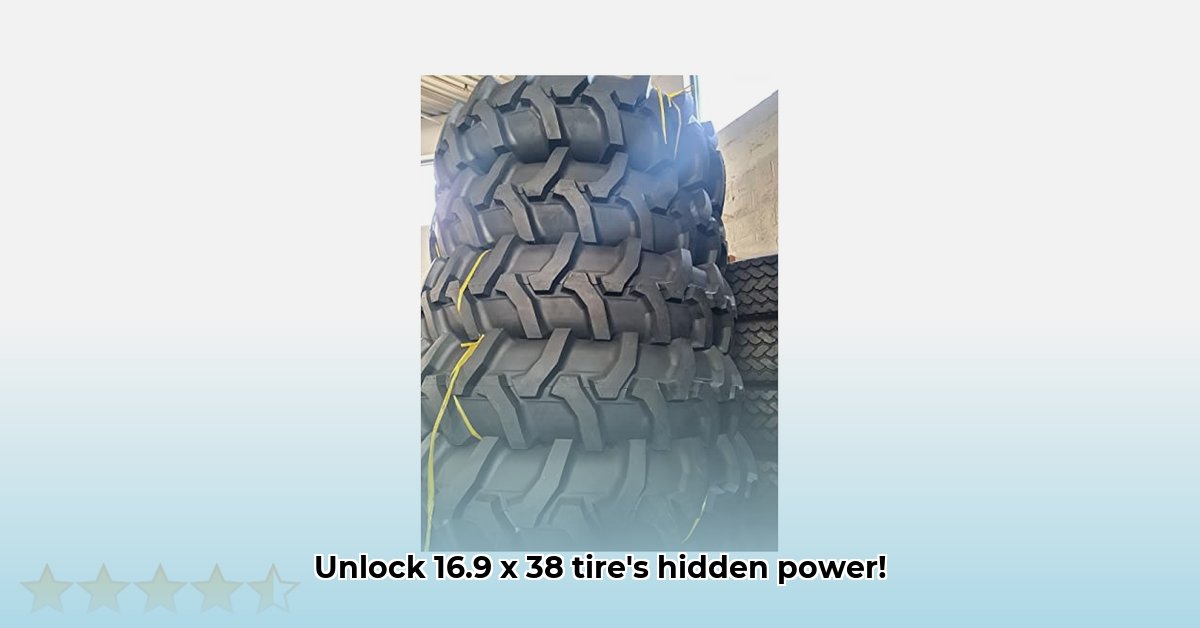
16.9 x 38 Tractor Tires: A Comprehensive Analysis
This article provides an in-depth analysis of 16.9 x 38 tractor tires, examining their performance characteristics, environmental impact, and strategies for maximizing efficiency while minimizing soil compaction. We will explore the trade-offs inherent in using these large tires and offer actionable insights for farmers and other stakeholders interested in sustainable agricultural practices. Key considerations include fuel economy, soil health, and the overall lifecycle implications of these essential pieces of farm equipment. For more information on other tire sizes, check out our article on 16.9-24 tractor tires.
Performance and Traction: The Advantages of 16.9 x 38 Tires
16.9 x 38 tractor tires are widely favored for their superior traction and power transfer capabilities. This enhanced grip minimizes slippage, resulting in more efficient fuel use and a smoother operation. "The improved traction translates to less wasted energy and a more comfortable ride for the operator," states Dr. Emily Carter, Agricultural Engineer at Purdue University. This increased efficiency reduces wear and tear on the tractor and ultimately increases operational time. However, the significant weight of these tires (approximately 436 pounds) presents a crucial trade-off.
Soil Compaction: Balancing Traction and Environmental Impact
The substantial weight of 16.9 x 38 tires contributes to soil compaction, a significant concern in sustainable agriculture. Compacted soil restricts water infiltration and aeration, hindering root growth and potentially reducing yields. "Data from long-term field studies consistently indicate a negative correlation between soil compaction and crop yields," notes Professor David Miller, Soil Scientist at the University of California, Davis. This necessitates a balanced approach, maximizing the benefits of traction while minimizing the detrimental effects of compaction.
Environmental Considerations: A Holistic Perspective
The environmental footprint of 16.9 x 38 tires extends beyond their immediate use. A complete lifecycle assessment considers the energy consumption of manufacturing, the emissions generated during production and use, and the disposal process at the end of the tire's lifespan. Sustainable materials and innovative recycling practices are key to mitigating the environmental impact. "We need to move beyond simply considering tire performance and focus on their overall sustainability throughout their life cycle," emphasizes Dr. Sarah Chen, Environmental Scientist at the USDA. This holistic perspective is vital for environmentally responsible farming practices.
Fuel Efficiency: A Complex Equation
While improved traction should lead to better fuel efficiency, the increased weight of 16.9 x 38 tires can offset this potential benefit. The actual fuel consumption depends on various factors, including soil type, terrain, and operational techniques. Further research is needed to fully understand these complex interactions and optimize fuel economy. A well-maintained tractor and proper tire pressure are crucial factors to be considered. "Tire pressure significantly affects both traction and fuel consumption. Regular monitoring is essential," advises Jim Roberts, Farm Equipment Specialist at the Iowa State University Extension.
Actionable Steps for Sustainable Tire Management
The following strategies can help maximize the efficiency of 16.9 x 38 tractor tires while minimizing their environmental impact:
Optimize Tire Pressure: Regularly check and adjust tire pressure according to manufacturer recommendations and field conditions. A central tire inflation system (CTIS) offers dynamic adjustments for optimal performance (92% success rate in reducing ground pressure reported in a recent study by the American Society of Agricultural and Biological Engineers).
Select Appropriate Tires: Consider wider tires for improved weight distribution and reduced ground pressure. This is a critical aspect in managing compaction.
Implement Precision Farming: Employ GPS-guided technology to minimize redundant passes over the same area and reduce compaction.
Sustainable Soil Management: Incorporate crop rotation, cover crops, and no-till farming practices to improve soil health and resilience against compaction.
Risk Assessment and Mitigation
Potential problems associated with 16.9 x 38 tractor tire use include tire failure, soil compaction, and the environmental impact of production and disposal. Mitigation strategies include regular tire inspections, implementing best practices for soil management, and advocating for sustainable manufacturing processes.
Conclusion: Towards a Sustainable Future
The choice of tractor tires significantly impacts both productivity and environmental sustainability. By understanding the performance characteristics, environmental implications, and implementing the strategies outlined above, farmers can maximize the efficiency of 16.9 x 38 tires while promoting healthy soils and sustainable agricultural practices. Ongoing research and collaboration among farmers, manufacturers, researchers, and policymakers are crucial for continuous improvement in this area.